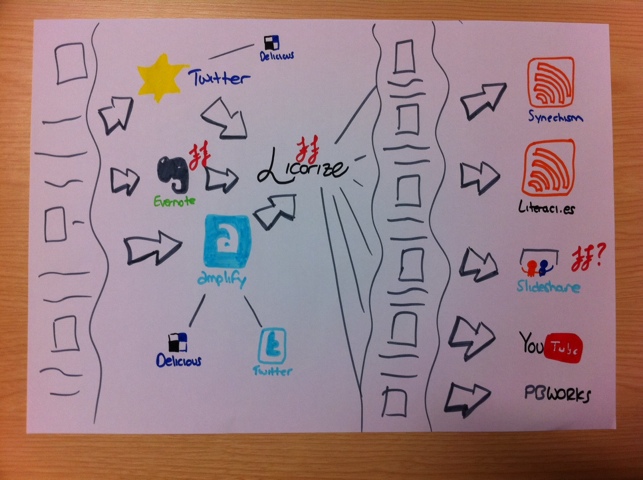In a move that will no doubt shock known world, I’ve decided that first-ever journal article will be both a collaborative venture and cock a snook towards traditional subject disciplines. Provisionally entitled Seven types of ambiguity and digital literacy I’m co-authoring it with my Ed.D. thesis supervisor Steve Higgins. Allegations that I’m doing so to prove originality in my research ahead of my viva voce by producing an article from an intended thesis chapter are, of course, completely unfounded.

I’m not going to give an overview of the entire article (for obvious reasons) although it will be published in an open-access journal. Suffice to say that we’re introducing the idea that terms such as digital literacy and digital natives/immigrants exhibit a ‘trajectory of ambiguity’ through which they pass on the way to becoming what Richard Rorty calls ‘dead metaphors’.
To prevent you having to go back and do Philosophy and Linguistics 101 I’ll remind you that the denotative aspect of a term is its surface or primary meaning. The connotative aspect of a term is its secondary, or implied, meaning. In the article, which features the overlapping diagram above (I’m not allowed to call it ‘Venn’, apparently) we’re arguing that there are three distinct phases through which terms pass. Whilst they never completely shed their connotative aspect the edge to the right of ‘Productive ambiguity’ is where the dictionary definition of terms reside. Generative ambiguity tends to be ‘blue skies thinking’, Creative ambiguity discussing and debating the definition of a term, and Productive ambiguity putting it into practice in various contexts.
You’ll be delighted to learn that we’ve done a sterling job in making the article itself ambiguous, situating it in the phase of Creative ambiguity. “Be the change you want to see,” “walk the walk,” etc.
The JISC infoNet team of which I am part are presenting at the Support Northumbria conference next month. We’re presenting a smorgasbord of delights for delegates with my part focusing upon workflows.
We’ve done plenty of work as a team on mapping our workflows but, given the fast-paced world we work in, I’ve not thought through mine as a researcher for a while. I decided to break out the crayons this afternoon, therefore, and think through both what I’m currently doing and how I can make that process more effective.
The first thing I did was to create four columns, reflecting what I consider to be the stages of research I go through:
- Inputs
- Lenses
- Curation
- Synthesis
Once I’d done that I placed every web app I use regularly into one of the columns (or ‘other’) and then identified which are core to my productivity. Then I thought how they fit together and how I could hone my workflow. I came up with this:

The grey river thing to the left stands for sources of information whilst the one in the middle for projects (current and potential).
I’ll no doubt have missed out something huge, but it was an interesting process to go through. I realised, for example, that I need to pay for Evernote on a yearly basis (I’ve been paying on an ad-hoc monthly basis) and use it more consistently. Also, I hadn’t carried out the very simple step of auto-feeding my Amplify RSS into Licorize as I had done with my starred twitter items!
At the end of the day it is a blog post which exists to encourage people to buy anti-virus products. And yet, an article with the title Criminals Exploiting Japan’s Tragedy: A Chance to Teach Digital Literacy which does not go on to address digital literacy even once serves to illustrate a point.
As argued elsewhere, e-safety (which, ultimately, is the focus of the article) is an output of digital literacy, not an input. There is no course that an individual can take that would teach them to be completely ‘safe’ online. Immersion and a the ability to critically ‘read’ online is key. As in life offline, scams and deceptions evolve as they are practices originating in human thought and action.
If e-safety is an output then digital literacy as a concept needs to explicitly address the ‘critical’ element of literacy involved in reading and writing online. There is, however, no ‘body of knowledge’ or skills that can be packaged up and distributed as cyber castor oil.


